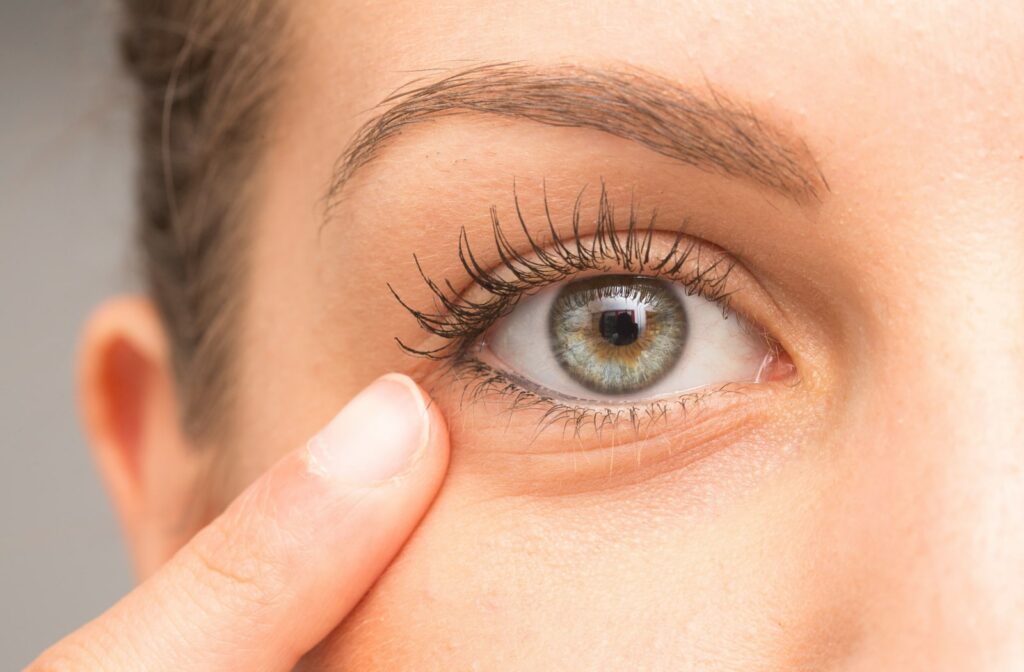Your tears are more than just water, and they need all their parts working together to keep your eyes protected and healthy. If not, you could experience dry eyes. While there are a few different causes for dry eyes, one of the most common is clogged meibomian glands. Fortunately, your optometrist can help.
We can use a variety of modern treatments to unclog meibomian glands, such as intense pulsed light, LipiFlow, and BlephEx treatments. With these therapies and a personalized management plan, we can help you work toward getting relief from frustrating dry eye symptoms.
What Is Meibomian Gland Dysfunction?
Meibomian gland dysfunction (MGD) is often the cause of dry eye. In fact, MGD is related to 85% of dry eye cases. This is because your meibomian glands, located along your eyelid, secrete an oil called meibum that is essential for stopping your tear film from evaporating too quickly.
In a healthy eye, meibum is released with each blink in 1 of your tear film’s 3 layers. The layers of your tear film include:
- The inner mucus layer, which helps your tears stick to your eye.
- The middle watery layer, which helps keep your eye moistened and protect it from bacteria.
- The outer oily layer, which is formed from meibum and helps stop the other layers from evaporating too quickly.
In cases of MGD, your meibomian glands can become inflamed or blocked. As a result, your tear film can become unstable, leading to increased tear evaporation and dryness.
In addition to dryness, MGD can lead to other dry eye symptoms, including:
- Scratchiness
- Burning sensations
- Redness
- Watery eyes
- Light sensitivity
- The feeling of something being stuck in your eye
- Blurry vision
We can diagnose MGD during an eye exam. If we suspect you have dry eye, we can examine your eyelids and tear film health. Advanced imaging equipment like LipiView can help us assess the structure and function of your meibomian glands and look for signs of blockage.

Causes of Meibomian Gland Dysfunction
There’s rarely a single cause of MGD. Rather, it’s usually a combination of factors that can make you vulnerable to developing this condition. Some people even have a genetic predisposition to developing MGD.
Some common risk factors include:
- Being over 50
- Biological sex
- Dry environments
- Lack of omega-3 fatty acids in your diet
- Wearing contact lenses
- Hormonal changes
- Certain medications
- Eye cosmetics
Unclogging Meibomian Glands
Mild dry eye symptoms can often be addressed with over-the-counter artificial tears, which can keep your eyes hydrated until your body can catch up. This can be most effective when the cause is due to dry environments or temporary changes, such as using a new medication.
However, if your dry eye symptoms are persistent and affect your daily life, you could benefit from a more comprehensive and personalized treatment. Your therapy begins with an assessment to determine the underlying cause of your dry eyes—so we can determine the right treatment to help you get long-term relief.
Intense Pulsed Light (IPL) Therapy
Intense pulsed light (IPL) therapy can help reduce the inflammation in your meibomian glands with precise wavelengths of light. IPL treatment can target clogged meibomian glands, removing the inflammation that can cause blockages and promoting the healthy flow of oils.
IPL therapy is typically quick, and some people see results as quickly as the third or fourth session. After the treatment is done, your optometrist can also express your meibomian glands to gently massage the blockages clear.
Because IPL therapy can be done in-office, you can typically return to your daily activities following your appointment.
BlephEx Treatments
Over time, our eyes can attract excess bacteria or accumulate biofilm from proteins in our tears and skin. BlephEx is a specialized procedure designed to remove this biofilm and unclog eyelid oil glands.
The process is usually quick, and though it may tickle slightly, many people find it easily bearable thanks to numbing drops. You can typically even return to work or family time right after the procedure.
LipiFlow Thermal Pulsation System
Lipiflow uses heat and gentle pressure to break down the hardened lipids clogging your meibomian glands. As such, this type of thermal meibomian gland expression could be considered the cousin of IPL treatment, just focusing on heat.
This procedure involves placing a device over your eyelids that uses heat pulses to gently warm your meibomian glands. Eventually, the heat can help liquefy the oil, and then gentle pressure from the device can help clear obstructions from your clogged glands.
Comprehensive Eye Care for Dry Eyes
At Precision Eye Care, we’re dedicated to providing personalized care for you and your family. So whether you need IPL, LipiFlow, BlephEx, or something more, it’s possible to find relief and comfort with the right treatment.
Don’t let dry eyes ruin your day any longer—take the first step toward relief by booking an appointment in Vancouver or Spokane today.





